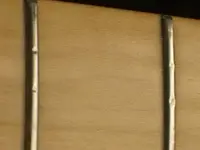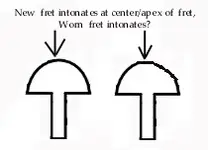Many 'experts' say we can only really hear and distinguish a difference of 5-6 cents. A typical guitar is maybe 16 cents flat in the minor 3rd and 14 cents sharp in the major third. Or something like that, when using an equal temperament. I'm probably off a little on those numbers, but the point is you would think you'd hear frets that were pitted (playing chords would just sound wrong), resulting from you not hitting the note right on the crown of the fret.
I don't think anyone can "hear a bad fret" so to speak....but I find the whole tuning thing somewhat frustrating at times while also rather intriguing in a pleasant/amusing way....how each guitar has it's own tuning personality even if they are the same kind of guitar, same frets and same identical setup.
AFA hearing out of tune stuff...if I just trying listen to a single note, it's hard to tell specifically how much off it is, and yeah, in that regard I think most people have similar tolerances if their ears are trained to listen to music analytically.
What I find curious is that when I'm actually playing chords and following a specific melody...I can hear very, very small tuning issues easily.
Some days it's so acute, that it can be annoying, because after maybe one pass of the song, I'll hear a string j-u-s-t starting to go out, and so I'm stopping to retune...and then when I grab the tuner, which has 1/10th of a cent accuracy, I'm surprised at just how very little the string had gone out, a few tenths only, something you would not notice jujst hitting the note by itself.
I recently decided to use a different intonation SOP...which I think is helping a lot in keep the guitar more "flexible" AFA small tunning discrepancies up and down the neck as I play.
In the past I always used the "standard" intonation SOP... hit the 12th harmonic and match it against the pressed note at the 12th (some people would use a different point or multiple points of harmonic and pressed notes).
What I started doing (so far on two guitars)...is to forget about the harmonic altogether. IMO, that's great for acoustics and people who play a lot of open chords and spend most of their time in the first 3 frets...and same thing for those who tune with open strings.
IMO, that approach doesn't work as well for electric guitars where you play a lot of barre chords and mostly pressed notes all over the neck, even well past the 12th fret.
So...instead of intonating with harmonics, I do it by pressing the string at two points...the 5th and 17th frets, and I set the intonation based on the difference between them.
IOW I adjust the saddle so that the pressed notes are equally close to being in tune for both notes. At the 5th the note might end up being 3 "ticks" flat while at the 17th 3 "ticks" sharp...it's not the amount of difference from perfect tune that counts, but the their differences offsetting each other.
Sometimes they will end up both perfect...it doesn't matter if they don't (and some won't) as long as you have an equal amount of +/- at each note so they offset, or if you will, "neutralize" each other.
Doing that for all 6 strings, I find that the guitars sound MUCH better all over the neck, so the amount of adjustment you need to make while actually playing is much less, and I'm actually quite impressed at how much less.
Also...they seem the hold tune much longer for more prolonged periods of play.
Same thing with actual tunning...I don't hit the open strings, I usually press the strings at the 8th fret and tune it there....because I'm mostly playing pressed notes, not open strings. Sometimes if I know I'm going to spend the entire song only in the first 3-5 frets or mostly in the high end....I'll press the notes in that range when tuning, to get the extra fine tune in that area, but for overall playing, I press them around the middle of the neck, but with this new intonation SOP, I'm finding little need to that, to tune in a specifc area of the neck for a given song since my the "overall tuning" using the middle of the neck (8th fret) just works fine for the entire range.
Oh...I was only kidding about buying a lot of guitars to avoid re-fretting.

I just like buying guitars.





 and is my face red!
and is my face red!
